#United States Naval Observatory
Text
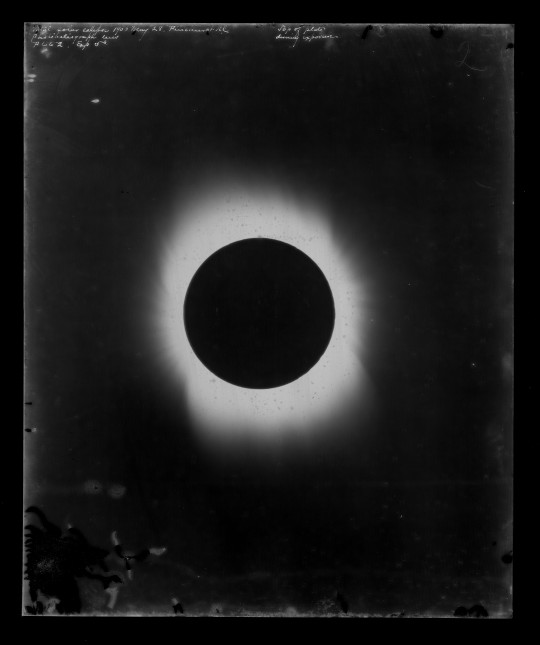
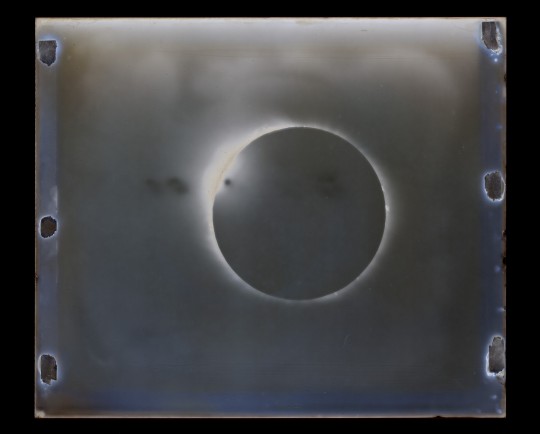
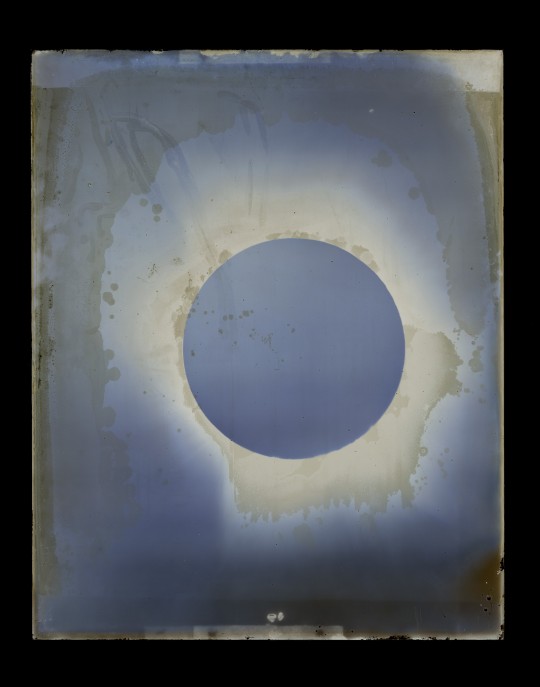



Digitized plates of solar eclipses from the United States Naval Observatory Library & Archives
Locations and years of eclipses:
Pinehurst, North Carolina. May 28, 1900
Limerick, Maine. August 31, 1932
Iloilo, The Philippines. May 9, 1929
Guelma, Algeria. August 30, 1905
Fort De Kock, Sumatra. May 17, 1901
Barnesville, Georgia. May 28, 1900
#astronomy#solar eclipse#archive#space#moon#United States Naval Observatory#astronomical photography#glass plate negative#internetarchive
2K notes
·
View notes
Text

In 1913, Brooklyn-based engineer Carrol Livingston Riker approached the papers with a plan to solve the issue of cold winters in Canada and New England... by diverting the Gulf Stream that provides Western Europe with its temperate climate so that the warm ocean currents provide their benefits to the Eastern parts of North America instead, such as warmer winters and fewer icebergs.
The manner with this would be achieved, Riker states, would be by building a 200 mile long pier off the coast of Newfoundland along the Grand Bank to where the deep ocean begins, meaning that in places the pier would have to be some 300 plus feet deep in places.
Naturally the fact that this would plunge the British Isles and Western continental Europe into freezing winters that match those in Northern Canada (Britain being at the same latitude as places like Labrador, Canada) isn't lost on the writers of the article in the St Louis Star and Times, nor the fact that as Canada was a British colony at the time which the United States would have to potentially annex to complete the megastructure, but Riker considers the overall net good (for Americans) makes the benefits outweigh the costs.
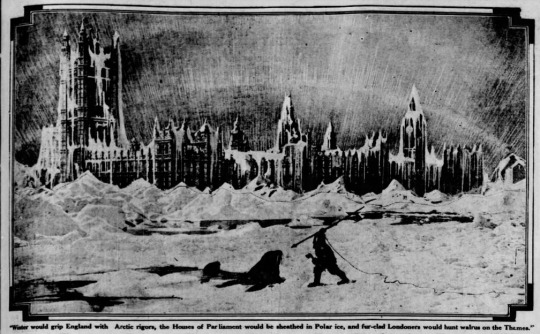
Despite the devastating climate catastrophe for Europe (the Star and Times amusingly suggesting that it could also cause the poles to shift) that could occur from this theoretical plan, Riker nonetheless received support from folk from both Harvard and Yale, in addition to the United States Naval Observatory, with the engineer also presenting his arguments so successfully to New York Representative Calder he attempted to introduce a bill to Congress to obtain funding for the project...
This did not actually happen, obviously, but it bring to mind a similar project first proposed in 1928 by German architect Herman Sörgel, which he named Atlantropa. Here Sörgel proposed damming and draining the Mediterranean, with the control flow of water through dams at Gibraltar and other points around the sea, which he theorised would create endless energy, new resources and uncovered land for people to settle in Southern Europe and Northern Africa.
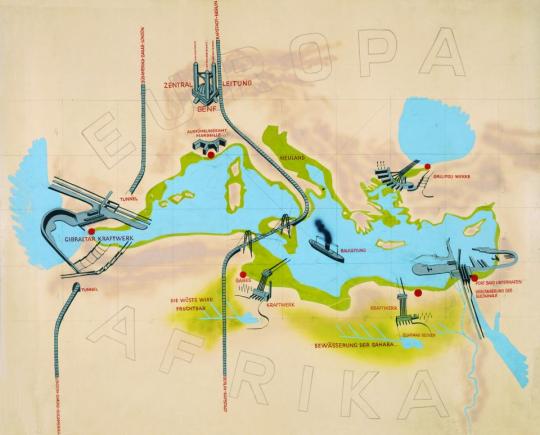
However, much like Riker's pier, this would have ALSO created horrible climate change issues (rather than creating new farmland it would essentially turn the Med into a giant salt desert, which the sun would heat further causing the potential desertification of Southern Europe), technological issues with constructing the project in the first place, would have bankrupted all the countries that required access to the Med to trade, AND further opening up Africa and the Middle East to even more colonisation efforts by European powers.
23 notes
·
View notes
Photo

The USNO Millennium Time Ball
Credits: United States Naval Observatory
11 notes
·
View notes
Text
Thunder Moon illuminates night sky over Temple of Poseidon in Athens
The full moon rose behind the Temple of Poseidon at Cape Sounion in Athens illuminating the historic site with its glow. Footage captured on Saturday shows the full moon ascending behind the ancient temple, casting its light on the water below, and offering a stunning view of the celestial event.

The full moon, known as the 'thunder moon,' reached its pinnacle illumination on July 21, with visibility in the United States at 10:17 GMT, according to the US Naval Observatory. It is also referred to as the 'buck moon' due to the time buck deer grow new antlers, as well as 'hay' or 'mead' moon by Europeans to reflect seasonal activities. This July the Moon is in Capricorn, an Earth sign, highlighting a zodiac significance for astrological enthusiasts. | Video Viory
0 notes
Text
Events 6.22 (after 1940)
1940 – World War II: France is forced to sign the Second Compiègne armistice with Germany, in the same railroad car in which the Germans signed the Armistice in 1918.
1941 – World War II: Nazi Germany invades the Soviet Union in Operation Barbarossa.
1942 – World War II: Erwin Rommel is promoted to Field Marshal after the Axis capture of Tobruk.
1942 – The Pledge of Allegiance is formally adopted by U.S. Congress.
1944 – World War II: Opening day of the Soviet Union's Operation Bagration against the Army Group Centre.
1944 – U.S. President Franklin D. Roosevelt signs into law the Servicemen's Readjustment Act of 1944, commonly known as the G.I. Bill.
1945 – World War II: The Battle of Okinawa comes to an end with an American flag-raising ceremony.
1948 – The ship HMT Empire Windrush brought the first group of 802 West Indian immigrants to Tilbury, marking the start of modern immigration to the United Kingdom.
1948 – King George VI formally gives up the title "Emperor of India", half a year after Britain actually gave up its rule of India.
1962 – Air France Flight 117 crashes on approach to Pointe-à-Pitre International Airport in Guadeloupe, killing 112 people.
1965 – The Treaty on Basic Relations between Japan and the Republic of Korea is signed.
1966 – Vietnamese Buddhist activist leader Thích Trí Quang was arrested as the military junta of Nguyen Cao Ky crushed the Buddhist Uprising.
1969 – The Cuyahoga River catches fire in Cleveland, Ohio, drawing national attention to water pollution, and spurring the passing of the Clean Water Act and the creation of the Environmental Protection Agency.
1978 – Charon, the first of Pluto's satellites to be discovered, was first seen at the United States Naval Observatory by James W. Christy.
1979 – Former Liberal Party leader Jeremy Thorpe was acquitted of conspiracy to murder Norman Scott, who had accused Thorpe of having a relationship with him.
1984 – Virgin Atlantic launches with its first flight from London to Newark.
1986 – The famous Hand of God goal, scored by Diego Maradona in the quarter-finals of the 1986 FIFA World Cup match between Argentina and England, ignites controversy. This was later followed by the Goal of the Century. Argentina wins 2–1 and later goes on to win the World Cup.
1990 – Cold War: Checkpoint Charlie is dismantled in Berlin.
2000 – Wuhan Airlines Flight 343 is struck by lightning and crashes into Wuhan's Hanyang District, killing 49 people.
2002 – An earthquake measuring 6.5 Mw strikes a region of northwestern Iran killing at least 261 people and injuring 1,300 others and eventually causing widespread public anger due to the slow official response.
2009 – A Washington D.C Metro train traveling southbound near Fort Totten station collides into another train waiting to enter the station. Nine people are killed in the collision (eight passengers and the train operator) and at least 80 others are injured.
2012 – Paraguayan President Fernando Lugo is removed from office by impeachment and succeeded by Federico Franco.
2012 – A Turkish Air Force McDonnell Douglas F-4 Phantom II fighter plane is shot down by the Syrian Armed Forces, killing both of the plane's pilots and worsening already-strained relations between Turkey and Syria.
2015 – The Afghan National Assembly building is attacked by gunmen after a suicide bombing. All six of the gunmen are killed and 18 people are injured.
2022 – An earthquake occurs in eastern Afghanistan resulting in over 1,000 deaths.
0 notes
Text

Texas last experienced a total solar eclipse in 1878.
Flashback:
People worried that the morning's clouds would obstruct views of the afternoon eclipse.
"But at 3 o'clock the heavens were clear in the vicinity of the sun, and joy was manifest with all the anxious watchers," the Fort Worth Daily Democrat wrote.
The stars became visible around 4pm.
The temperature cooled roughly 13 degrees as the eclipse moved through Texas, per the Ellis County Museum.
The Galveston Daily News said the sight was "indescribable."
What's next: April 8 will be our only chance to witness a total solar eclipse — the next one in our region won't be until 2317.

1878

Smoked glass, sextants — and a new planet
1878 totality left Dallas in awe, eager for discoveries
Clouds hung low in the sky the night before, and by sunrise they still hadn’t cleared.
“All the morning people were seen carrying their pieces of smoked glass,” a predecessor to modern eclipse glasses, wrote a Ross Avenue woman.
The woman, N.L. Belsterling, had made her pieces of glass herself, but newsboys were selling them across the country.
“I, too, smoked my piece manfully — no, womanfully — at the risk of cut and burnt fingers, and succeeded in getting a piece well blackened,” she recalled in a letter decades later. “Several scientific gentlemen,” she added, were on hand.
Dallas was 36 years old and about to see its first total solar eclipse — if the weather would cooperate.
Ahead of Monday’s total solar eclipse, The Dallas Morning News conducted archival research on the 1878 eclipse, shedding light on its legacy in the region.
The event, like today, was a sensation.
For decades, observers recalled the moon’s shadow and the preparations that heralded the eclipse’s arrival.
No total solar eclipse had crossed the state since the arrival of Europeans centuries earlier, this paper wrote. And for the country, the stakes were even higher.
“It was a really important day for America and for American science because this was a time when the United States was still a young country,” David Baron, author of American Eclipse , said in an interview with The News .
Just two years earlier, America had celebrated its centennial and was becoming a global industrial power.
“But when it came to intellectual pursuits,” he said, “the Europeans looked down their noses at us,” confident the U.S. would never catch up. The date of July 29, 1878, was America’s chance to prove its intellectual might matched its economic muscle — and the public, galvanized by science they could see — was on board.
Eclipse expeditions
Knowing bad weather could spoil any one viewer’s observations, the U.S. Naval Observatory had launched about a half dozen eclipse expeditions across the country.
The zone of total darkness cut a path east from Russia to Alaska, crossed through British Columbia and traced large parts of the Rockies before entering Texas, where it curved out into the Gulf of Mexico and eventually passed over Cuba.
The chances of clear skies were better in Colorado and Wyoming, said Baron, so more resources were allotted to those expeditions. (Thomas Edison was among the scientists in Wyoming, though he was on a private trip.) In Dallas, things were a bit more DIY.
David Todd arrived by himself in Denison on July 12 after a four-day trip from Washington, D.C., according to the report he later submitted to the Navy.
A 23-year-old astronomer, Todd brought with him a $500 budget; a sextant; a chronometer; and a comet seeker, a type of small telescope.
“Todd was a one-man expedition,” Baron said. “The other expeditions were much more elaborate — more people, more equipment.”
In Wyoming, Edison brought along a device he called along the tasimeter, which he claimed could register changes in temperature as tiny as a millionth of a degree Fahrenheit, according to Baron. Billed as “bigger than the phonograph,” it turned out not to be very reliable.
The sun’s corona
Todd got situated, setting up communication with Washington and with people across Texas drafted to make their own observations of the eclipse and the sun’s corona, a mysterious phenomenon to scientists at the time.
“It was recommended that drawings of the corona be made at the three stations nearest the center of the shadow-path, namely Decatur, Jacksborough, and Henrietta,” he wrote in his report.
After a detour to Houston to pick up extra equipment, he returned to Dallas on Saturday night, two days before the eclipse, and checked in on his headquarters, the house of J.M. Oram, a local jeweler.
The house was about a quarter-mile from the telegraph office, and Todd later boasted of having someone on horseback standing by at the facility to grab any message that might come in from Wyoming during the eclipse and rush it to him “with all possible despatch.”
Like the other scientists around the country, Todd saw in the eclipse a rare chance to bring clarity to two big scientific mysteries.
The first was the corona, which becomes visible when the moon obscures the sun in what’s known as totality.
Scientists today know the corona is the sun’s outer atmosphere, but 19th-century theories ran the gamut.
Was it even a part of the sun? Maybe it was an effect of the Earth’s own atmosphere on the sun’s light, said Baron.
One theory, he added, even posited it was meteors burning up as they fell into our star.
By 1878, scientists had ruled out the most outlandish hypotheses, settling on a consensus that the corona was in fact part of the sun, but that was about as far as they’d gotten.
The other question the eclipse could answer was perhaps even bigger by today’s standards.
Scientists hoped in the span of mere minutes to catch a glimpse of an entirely new planet they believed existed — without having been definitively observed.
The planet Vulcan
“There was good reason to believe that there was at least one other planet between Mercury and the sun,” Baron said. “The belief was so great that in fact astronomers gave it a name.” They called it the planet Vulcan.
Vulcan, astronomers thought, had to exist to explain a quirk in Mercury’s orbit.
“Mercury behaved as if there was some mass between it and the sun, tugging it along,” Baron said. The problem was that “No one had ever reliably seen Vulcan.”
But that didn’t necessarily mean it wasn’t there.
Astronomers theorized if the planet was close enough to the sun, it would set with the sun at dusk, never to be seen in the night sky.
Daytime observation would be impossible, owing to the sun’s glare.
“So, about the only time you might catch a glimpse of this supposed planet Vulcan would be during those few minutes of midday
darkness when the moon covers the bright surface of the sun and you could actually look at what is right around the sun,” Baron said.
Todd’s position in Dallas meant he wouldn’t be the first to spot Vulcan in 1878, but he might get a tip by telegram about where to point his telescope if another observer saw it before him.
As the big day wore on, the weather improved.
Only high clouds floated when the phenomenon was due.
Todd stood by his instruments at Oram’s house and his volunteers took their places, too.
Smoked glass in hand, the city looked up at about 3:14 p.m.
About an hour later, totality began.
“I almost held my breath in awe,” wrote Belsterling, the Dallas woman who saw it with her own eyes.
“The birds, overhead, blew hither and thither in alarm.
Chickens went to roost and began their pecking and crowding, preparatory to their night’s rest.
The frogs on the banks of the Trinity set up their sad, musical refrains.
As totality passed and the first rays of the sun fell upon us the scene was one of rare brilliancy.
I watched it as it slowly passed over, and felt sorry it was over.”
The next one wouldn’t be until 2024.
Belsterling’s account, captured in a letter, appeared in The News 50 years later.
She’s one of several Texans whose memories of the eclipse stayed with them for decades and resurfaced in newspaper coverage that looked back on the event.
‘Wonder and awe’
Ola Comer Haley, a young girl in Pittsburg, Texas, northeast of Tyler, watched the eclipse with her family in 1878 and told the Dallas Times Herald 45 years later, “I shall never forget the look upon mother’s face as I looked into it and saw an expression of wonder and awe, which as a little child, I mistook for sadness.”
Todd’s observations were less sentimental.
Tables and measurements make up his detailed report on what he saw during his stargazing.
But he did look back on his time in the city half a century later, calling himself a young scientist whom “a kindly cloudless sky favored so that Dallas has ever since held unchallenged a grateful nook in his heart.”
In the days and weeks after the eclipse, headlines shouted news of scientific breakthroughs. But as often happens in hindsight, little of the science held up.
“I mean, you know, this was the most important eclipse ever observed,” said Baron, miming the refrain of the time. “And Vulcan was found!” But of course, there was no Vulcan, he said. Studies of the corona turned out not to have revealed much either.
Still for Todd, it was the beginning of a long career.
After packing up his comet chaser, he went on to become a professor at Amherst College in Massachusetts and an eclipse chaser whose expeditions took him around the world.
The Dallas expedition was his first. He died in 1939.
Baron said despite it being largely a scientific dud, the eclipse remained a turning point in the country’s intellectual history because it whet the public’s appetite for more discovery.
“Here was the scientific event that got America jazzed about showing the world that we could compete in this realm,” he said. “And it wasn’t long after this, that we really did lead the world in astronomy and many sciences.”
Signature moment
In Dallas, the events of 1878 became the stuff of legend, revived in the papers when a partial solar eclipse was visible here.
“You Can’t Find Eclipses Anymore Like One In ’78,” said a cheeky headline in 1963.
“When Dallas Watched The Sun Go Out,” read the front page of The News on the 50th anniversary.
That story took a more solemn tone, however, tributing the eclipse as a signature moment in the city’s history.
“It was an event anticipated with immense interest and caused the greatest possible excitement,” the writer, Geoffrey E. Govier, declared.
At the end, Govier’s tone softened into something more contemplative as he pondered whether eclipses would mean as much in the future.
He told readers the next total eclipse in Texas wouldn’t be for nearly a century and, in the last sentence, made an admission: “enthusiasm for these far-away darkenings of the Sun is naturally feeble,” he wrote, “and by that remote epoch further mysteries of space and time may have been penetrated.”
They certainly have, but we’ll still be watching.
0 notes
Text
Eclipse Helped to See Solar Corona in New Light - Technology Org
New Post has been published on https://thedigitalinsider.com/eclipse-helped-to-see-solar-corona-in-new-light-technology-org/
Eclipse Helped to See Solar Corona in New Light - Technology Org
Observations made by William Harkness during the 1869 total eclipse led to a pivotal discovery about the sun’s corona.
[embedded content]
When it comes to studying solar eclipses, University of Rochester scholars have been at it a long time. Case in point: Alumnus William Harkness, whose observations of the sun’s corona during a total solar eclipse in 1869 have been hailed by some astronomers as a “landmark discovery.”
At the time, few people had ever gotten a good look at the solar corona—the outermost jacket of gases that make up the sun’s atmosphere. The sun’s blinding brilliance made studying anything in its immediate vicinity almost impossible. Only during eclipses did its radiant halo, the corona, become visible.
In fact, astronomers of the day debated whether the ring of light revealed during an eclipse was the sun’s atmosphere at all. Some thought it was just sunlight penetrating the Earth’s atmosphere. Others speculated it was a lunar atmosphere.
Here comes the sun’s corona
Harkness helped settle the debate by studying a solar eclipse on August 7, 1869, from a hilltop on the outskirts of Des Moines, Iowa, one of the cities in the eclipse’s so-called path of totality.
Vital to his research was his use of a relatively new instrument called a spectroscope, a glass prism that splits light into a rainbow of colors emitted by specific atoms and molecules. The hues act like a key to identifying different elements.
Affixing a spectroscope to a telescope enabled Harkness to observe a continuous green line ringing the sun as the moon slipped between it and the Earth and punched a hole of darkness in the daytime sky.
As documented by the United States Naval Observatory, Harkness concluded that the corona was “a highly rarefied self-luminous atmosphere surrounding the sun, and, perhaps, principally composed of the incandescent vapor of iron.”
“We have succeeded beyond our most sanguine expectations,” Harkness, who was a lieutenant commander and mathematics professor in the Navy at the time, wrote of his research in a telegraph to a colleague.
His missive was widely reported in newspapers across the country, from the Deseret News in Utah to the Burlington Free Press in Vermont.
“We have one hundred and twenty-three photographs of the eclipse, two being of totality,” he added. “. . . Could see no absorption lines in the spectrum of the corona. It gave a continuous spectrum with one bright line on it.”
His observations, which he photographed, were corroborated by those of Charles Augustus Young, an astronomy professor at Dartmouth College, who studied the same celestial event from a vantage point of roughly 160 miles east in Burlington, Iowa.
Harkness’s observations would eventually help answer the question, ‘Is the solar corona hotter than the sun?’
HARKNESS AND LIGHT: The total solar eclipse of August 7, 1869, as documented by William Harkness during his work to learn about the physical constitution of the sun’s corona, which is only visible during an eclipse. Image credit: University of Rochester Department of Rare Books, Special Collections, and Preservation
Scientists hypothesized that the green line might be the emission of a new element of the sun, which came to be known as coronium. They studied that green line during eclipses for the next seven decades before concluding that coronium was not a new element, but rather iron stripped of half of its electrons.
That finding suggested the solar corona was hotter—millions of degrees hotter—than the surface of the sun and has since helped the scientific community better understand how stars work.
Harkness, a member of the Class of 1858, was 11 years on from graduating from the University of Rochester at the time of his discovery, but he kept his alma mater in mind throughout his life. When he died in 1903, having reached the rank of rear admiral in the Navy, he bequeathed to the University his collection of nautical and scientific instruments as well as his library and papers.
Harkness Hall, which was erected on the River Campus in his honor in 1946 and originally devoted to naval science and training naval officers, today houses the Departments of Political Science and Economics.
Source: University of Rochester
You can offer your link to a page which is relevant to the topic of this post.
#ALMA#Astronomy#Astronomy news#atmosphere#atoms#Books#cities#Collections#college#colors#Community#continuous#earth#Earth’s atmosphere#eclipses#Economics#electrons#Fundamental physics news#green#how#iron#it#Learn#LED#life#Light#Link#Mathematics#mind#molecules
0 notes
Text
Bus of migrants dropped off outside VP Kamala Harris's home
Bus of migrants dropped off outside VP Kamala Harris’s home
Three buses carrying migrants from Texas arrived in Washington, D.C. late Saturday evening, including one which dropped its passengers near the home of Vice President Kamala Harris.
The U.S. Naval Observatory (USNO) is the official residence of the Vice President of the United States and the Christmas Eve drop-off is the latest of several instances in which Texas Gov. Greg Abbott has bussed…

View On WordPress
0 notes
Photo

Reports of observations of the total eclipse of the sun, August 7, 1869 [Reprint]
#Total Eclipse Of The Sun#Professor J. H. Coffin#August 7 1869#astronomy#eclipse#1869#United States Naval Observatory
36 notes
·
View notes
Text









Clock making stimboard for anon. Some clock facts:
🕰️ England’s Salisbury Cathedral Clock is world’s oldest functioning clock, built in 1386.
🕰️ The NIST-F1 Cesium Fountain Clock is the world’s most accurate clock. Developed by the National Institute of Standards and Technology in Colorado, the clock will run precisely on time for the next 20 million years.
🕰️ In October 1971, Joseph C. Hafele and Richard E. Keating tested the theory of relativity by flying four cesium-beam atomic clocks twice around the world east and west. When they compared them to the clocks at the United States Naval Observatory, the clocks were no longer in sync, indicating time dilation had occured.
Sources: x x x / x x x / x x x
#requests#clocks#clockworks#gears#clock making#crafts#craft stim#stim#owl post#pocket watch#grandfather clock#perfect loop#trivia#fav
249 notes
·
View notes
Photo

Great comet of 1901, or Viscara Comet. Discovered in april 1901, from Paysandú, Uruguay. Photograph taken on the United States Naval Observatory expedition to Sumatra. The comet has a parabolic orbit, which means it will never return to the solar system.
Gran cometa de 1901, o Cometa Viscara. Descubierto en abril de 1901, desde Paysandú, Uruguay. Fotografía tomada por la expedición del Observatorio Naval de Estados Unidos a Sumatra, Indonesia. El cometa tenía una órbita aparentemente parabólica, lo que implica que nunca regresará al sistema solar.
#Comet#Cometa#Astronomy#Astronomia#Astronomía#Uruguay#Southern Hemisphere#Solar System#Sistema Solar#Space#Espacio#Outer Space#Espacio Exterior#Universe#Universo
2 notes
·
View notes
Text
Events 2.4 (before 1940)
62 – Earthquake in Pompeii, Italy.
1576 – Henry of Navarre abjures Catholicism at Tours and rejoins the Protestant forces in the French Wars of Religion.
1597 – A group of early Japanese Christians are killed by the new government of Japan for being seen as a threat to Japanese society.
1783 – In Calabria, a sequence of strong earthquakes begins.
1810 – Peninsular War: Siege of Cádiz begins.
1818 – Jean-Baptiste Bernadotte ascends to the thrones of Sweden and Norway.
1852 – The New Hermitage Museum in Saint Petersburg, Russia, one of the largest and oldest museums in the world, opens to the public.
1859 – Alexandru Ioan Cuza, Prince of Moldavia, is also elected as prince of Wallachia, joining the two principalities as a personal union called the United Principalities, an autonomous region within the Ottoman Empire, which ushered in the birth of the modern Romanian state.
1862 – Moldavia and Wallachia formally unite to create the Romanian United Principalities.
1869 – The largest alluvial gold nugget in history, called the "Welcome Stranger", is found in Moliagul, Victoria, Australia.
1885 – King Leopold II of Belgium establishes the Congo as a personal possession.
1901 – J. P. Morgan incorporates U.S. Steel in the state of New Jersey, although the company would not start doing business until February 25 and the assets of Andrew Carnegie's Carnegie Steel Company, Elbert H. Gary's Federal Steel Company, and William Henry Moore's National Steel Company were not acquired until April 1.
1905 – In Mexico, the General Hospital of Mexico is inaugurated, started with four basic specialties.
1907 – Belgian chemist Leo Baekeland announces the creation of Bakelite, the world's first synthetic plastic.
1913 – Greek military aviators, Michael Moutoussis and Aristeidis Moraitinis perform the first naval air mission in history, with a Farman MF.7 hydroplane.
1913 – Claudio Monteverdi's last opera L'incoronazione di Poppea was performed theatrically for the first time in more than 250 years.
1917 – The current constitution of Mexico is adopted, establishing a federal republic with powers separated into independent executive, legislative, and judicial branches.
1917 – The Congress of the United States passes the Immigration Act of 1917 over President Woodrow Wilson's veto.
1918 – Stephen W. Thompson shoots down a German airplane; this is the first aerial victory by the U.S. military.
1918 – SS Tuscania is torpedoed off the coast of Ireland; it is the first ship carrying American troops to Europe to be torpedoed and sunk.
1919 – Charlie Chaplin, Mary Pickford, Douglas Fairbanks, and D. W. Griffith launch United Artists.
1924 – The Royal Greenwich Observatory begins broadcasting the hourly time signals known as the Greenwich Time Signal.
1933 – Mutiny on Royal Netherlands Navy warship HNLMS De Zeven Provinciën off the coast of Sumatra, Dutch East Indies.
1939 – Generalísimo Francisco Franco becomes the 68th "Caudillo de España", or Leader of Spain.
0 notes
Photo
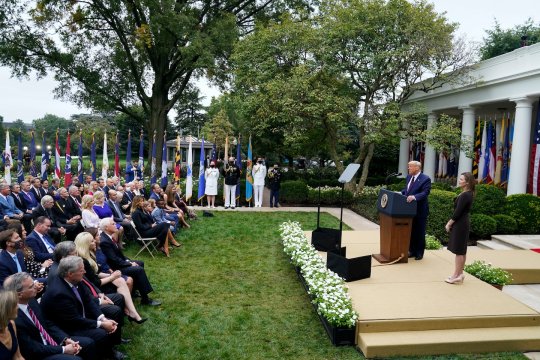
New Post has been published on https://techcrunchapp.com/invincibility-punctured-by-infection-how-the-coronavirusspread-in-trumps-white-house-the-washington-post/
Invincibility punctured by infection: How the coronavirus spread in Trump’s White House - The Washington Post

Spirits were high. Finally, Trump was steering the national discussion away from the coronavirus pandemic — which had already killed more than 200,000 people in the United States and was still raging — to more favorable terrain, a possible conservative realignment of the Supreme Court.
Attendees were so confident that the contagion would not invade their seemingly safe space at the White House that, according to Jenkins, after guests tested negative that day they were instructed they no longer needed to cover their faces. The no-mask mantra applied indoors as well. Cabinet members, senators, Barrett family members and others mixed unencumbered at tightly packed, indoor receptions in the White House’s Diplomatic Room and Cabinet Room.
Five days later, that feeling of invincibility was cruelly punctured. On Thursday, counselor to the president Hope Hicks, who reported feeling symptoms during a trip with the president to Minnesota on Wednesday, tested positive for the virus. Early Friday morning, Trump announced that he and the first lady also had tested positive and had begun isolating inside the White House residence.
On Friday, Lee, Conway and Jenkins announced that they, too, had tested positive, as did Sen. Thom Tillis (R-N.C.), who was at the ceremony, and Republican National Committee Chairwoman Ronna McDaniel, who had recently spent time with the president, including at an indoor fundraiser last week. At least three journalists who had been at White House events in the past week also reported testing positive on Friday. And White House Chief of Staff Mark Meadows said he was bracing for additional infections among administration officials.
By Friday afternoon, Trump’s condition had worsened, officials said, though they maintained he was “in good spirits.” The president had a low-grade fever, a cough and nasal congestion, among other symptoms, according to two people familiar with his condition who, like others interviewed for this story, spoke on the condition of anonymity to candidly discuss a sensitive matter.
Trump was transported about 6:16 p.m. Friday to Walter Reed National Military Medical Center for further treatment out of what the White House described as an abundance of caution.
As Trump’s condition deteriorated during the day Friday, the president and his team ultimately made the decision to send him to Walter Reed preemptively — and, from a public relations perspective, when he was still able to walk to Marine One on his own, according to one outside adviser in frequent contact with White House officials. They feared the possibility of a further decline, and what that might mean, both for the president’s health and his political optics.
The White House outbreak thrust Washington into a state of heightened alarm Friday, with uncertainty one month before the election about the health of the president, whose age of 74, as well as additional co-morbidities — obesity, high cholesterol and slightly elevated blood pressure — increase his risks of a negative outcome.
Though White House officials have begun contact tracing to try to identify the origin of the outbreak, it is not publicly known whether the Rose Garden announcement of Barrett’s nomination was a superspreader event.
Still, the jarring contrast between the carefree, cavalier attitude toward the virus on display in the Rose Garden last Saturday and the pernicious awakening that occurred Thursday night resembles a Shakespearean tragedy.
The White House’s handling of the period between the first known symptoms — those of Hicks on Wednesday — and the president’s infection, which was confirmed about 1 a.m. Friday, is what experts considered a case study in irresponsibility and mismanagement.
Administration officials at first were not transparent with the public, and have not been forthcoming with detailed information about Trump’s condition since. Meadows told reporters Friday morning only that Trump was experiencing “mild symptoms” and would not elaborate on what those symptoms were.
“I’m not going to get into any particular treatment that he may or may not have,” Meadows said.
On Friday afternoon, the White House distributed a memorandum by White House physician Sean Conley describing Trump as “fatigued but in good spirits.” Though Conley listed the drugs he had administered, he provided to the public no measurements of the president’s condition, nor did he nor any other knowledgeable source submit to questions from journalists.
‘Losing their minds’
Inside the West Wing’s narrow corridors, where staffers for months have worked in proximity largely without masks, what had long been an atmosphere of invincibility turned into one of apprehension and panic. “People are losing their minds,” said the outside adviser.
First, aides fretted about their own risks of exposure. If the president got infected, so might they.
Then they considered the political implications, coming so close to the Nov. 3 election. “We don’t want to be talking about coronavirus and now we’re talking about coronavirus,” the outside adviser said. “The hit writes itself: He can’t protect the country. He couldn’t even protect himself.”
Then they considered the reality that the president could actually get very sick. Trump was unusually quiet Friday, not appearing before cameras nor even calling into Fox News Channel by phone, as he does from time to time.
Vice President Pence, whose doctor said he tested negative for the virus Friday morning, worked from his residence at the Naval Observatory for the day. But other White House officials did not take the same precautions.
Ivanka Trump and Jared Kushner, the president’s daughter and son-in-law who both are senior advisers and have interacted with Trump and Hicks this week, tested negative on Friday, said White House spokeswoman Carolina Hurley. But she declined to answer questions about whether the two planned to self-isolate, and Kushner was seen at work in the White House on Friday.
Meadows, who also has had regular interaction with Trump and Hicks, did not wear a mask when he briefed reporters outdoors on Friday morning. Asked why, the chief of staff responded defensively, “I’ve obviously been tested. We’re hopefully more than six feet away.”
It was unclear where or how Trump contracted the virus, but his travel schedule has been robust all week. He visited five states between Sunday and Monday and interacted with hundreds of individuals.
The first sign of symptoms inside the presidential bubble came on Trump’s trip Wednesday to Minnesota, where he attended a campaign fundraiser in Shorewood and an evening rally in Duluth.
Hicks, who spends more time with the president than most staffers, tested negative for the coronavirus on Wednesday morning, but started to feel ill during the Minnesota trip. She self-isolated aboard Air Force One for the flight home that night, although some other aides on the trip were unaware she had done so. Hicks took another test Thursday morning, and the results came back positive.
Meanwhile, Trump’s voice sounded raspy at times during his rally performance in Duluth, and he delivered a shorter speech than is typical, clocking in at 46 minutes compared to other recent rally speeches that have stretched well past an hour.
On Thursday, Hicks’s diagnosis was kept secret from the public and even from some of her own colleagues. Press secretary Kayleigh McEnany did not know Hicks had the virus when she briefed reporters about 11 a.m., but learned midafternoon, as the president was preparing to depart for another campaign fundraiser, this one at his private golf club in Bedminster, N.J.
By then, word about Hicks’s condition had begun spreading among Trump aides. Some staffers suddenly started wearing masks, a sign that something was amiss. A few senior aides were pulled from the Bedminster trip, including McEnany, who had been around Hicks extensively that week and was replaced by one of her deputies, Judd Deere.
Other aides on the trip were Johnny McEntee, Tony Ornato and Brian Jack. None wore a mask on Air Force One, but they did aboard Marine One, considering the helicopter has far tighter quarters than the airplane.
“Trump thought he could go to the fundraiser and keep it secret that Hicks had it,” Republican donor Dan Eberhart said.
Trump’s decision to proceed with the fundraiser after the known infection of Hicks, someone with whom he had extended recent close contact, went against the recommendations of the Centers for Disease Control and Prevention and other public health authorities.
“They knew she was positive and they still let Marine One take off with the president. Why didn’t they ground him? That was the break in protocol,” said Kavita Patel, a practicing physician and former health adviser in the Obama White House. “The CDC’s protocol clearly states that as soon as anybody, i.e. Hope Hicks, was confirmed positive, anybody she came into close contact with for at least 48 hours prior should have at least isolated.”
In Bedminster, Trump held a roundtable fundraiser indoors where donors were sitting around the table with him. Masks were not worn in the room. The president then went outdoors to address a larger group, and some of those attendees wore masks, people present said.
Many of the attendees were elderly, a mix of real estate figures and Trump friends, including Keith Frankel, a vitamins executive who had worked with Trump on hydroxychloroquine, an anti-malarial drug Trump had falsely touted as a coronavirus cure.
“It was mostly the same stuff you hear him say on TV,” Frankel said of the president’s remarks, describing them in an interview late Thursday before Trump had tested positive.
En route back to the White House, Trump acknowledged Hicks’s diagnosis to his traveling team and said he was going to be tested, people with knowledge of his comments said.
News of Hicks’s infection came late in the evening — not in a public release by the White House, but rather from a Bloomberg News report, which White House officials quickly confirmed. About 10 p.m., Trump called into his friend Sean Hannity’s show on Fox for a pre-scheduled interview, where the host asked him about Hicks contracting the virus. Trump said he had taken a test and was awaiting his results.
“You know, it’s very hard,” the president said, his voice again sounding raspy. “When you’re with soldiers, when you’re with airmen, when you’re with Marines, and I’m with — and the police officers. I’m with them so much. And when they come over here, it’s very hard to say, ‘Stay back, stay back.’ It’s a tough kind of a situation. It’s a terrible thing. So, I just went for a test, and we will see what happens. I mean, who knows?”
In another breach of standard protocol for controlling the spread of the virus, not everyone who had come into contact with the president was immediately notified by the White House’s contact tracers. Former New Jersey governor Chris Christie, who had been helping Trump with debate preparation earlier this week, said Friday afternoon that he had not been contacted. In addition, at least one journalist who tested positive after traveling with the president this week also had not heard from the White House as of Friday afternoon.
‘No one was distanced’
As White House officials worked to trace the origin of the outbreak, they became concerned about a series of events Saturday: Barrett’s Rose Garden announcement and the private indoor receptions surrounding it.
A feeling of invincibility from the virus was pervasive. Guests were administered rapid coronavirus tests upon arrival and waited in a room wearing masks, according to Jenkins, the Notre Dame president. Then, he wrote in a statement Friday, “we were notified that we had all tested negative and were told that it was safe to remove our masks.”
Once escorted outside, guests mingled in the Rose Garden shaking hands and hugging, then took seats positioned closely together. Jenkins said he regretted “my mistake” of not wearing a mask and shaking hands at the event.
The mixing continued at indoor receptions to celebrate Barrett, which two White House officials said Friday have caused deep concern within the president’s circle. They were attended by Cabinet members, senators, Barrett’s family, family members of the late Justice Antonin Scalia and other guests, including Fox News host Laura Ingraham.
“They were all mingling without masks and in close quarters,” one of the officials said. “No one was distanced.”
Rochelle Walensky, chief of the division of infectious disease at Massachusetts General Hospital and professor of medicine at Harvard Medical School, said a negative test is hardly a guarantee of immunity.
“People believe that if their test is negative, then they should be fine and the truth is that means you’re fine today,” Walensky said. “It doesn’t even mean you’re fine tonight, as the Thursday testing demonstrated.”
On the Friday night before the Barrett announcement, Trump attended an indoor fundraiser at the Trump International Hotel in Washington, along with McDaniel, Labor Secretary Eugene Scalia, lobbyist Brian Ballard and a coterie of Trump aides and allies.
McDaniel, who then spent two days with the president before beginning to show symptoms earlier this week, tested positive for the virus on Wednesday. She told the president about her infection on Friday morning, although she had notified some White House officials before then, according to two people familiar with the situation. She attempted to reach Trump sooner but did not get through to him and spoke instead with a White House doctor.
Trump’s non-socially distanced interactions continued throughout the week. After the Barrett announcement, Trump traveled to Middletown, Pa., to hold an evening campaign rally. On Sunday, he played golf at his private club in Northern Virginia, held a news conference at the White House and hosted a reception for Gold Star parents. On Monday, Trump spoke in the Rose Garden to update the nation on the coronavirus.
All the while, Trump held debate preparation meetings with Christie, Hicks, Conway, personal lawyer Rudolph Giuliani and a handful of other advisers. Neither Trump nor Hicks showed symptoms or wore a mask, according to two people with knowledge of the discussions.
“He was totally like himself,” Conway said.
Trump traveled Tuesday afternoon to Cleveland for his first debate with Democratic nominee Joe Biden. The candidates’ podiums stood 12 feet 8 inches apart, roughly double the recommended social distancing space of six feet, according to Frank J. Fahrenkopf Jr., co-chair of the nonpartisan Commission on Presidential Debates.
Fahrenkopf said the commission adopted changes to the routine because of the pandemic, including killing the typical meet-and-greet backstage. Everybody in the debate hall — other than Trump, Biden and moderator Chris Wallace of Fox News — was required to test negative for the virus and to wear a mask.
“The first family came in wearing masks, but they took them off,” Fahrenkopf said. “The rules said you had to wear a mask.”
Trump’s schedule continued apace Wednesday and Thursday. When he spoke about the virus in the Rose Garden on Monday afternoon, the president all but declared victory over the virus.
“Tremendous progress is being made,” he said. “I say, and I’ll say it all the time: We’re rounding the corner. And, very importantly, vaccines are coming, but we’re rounding the corner regardless.”
He could not have known then what was yet to come.
Amy Gardner contributed to this report.
2 notes
·
View notes
Photo
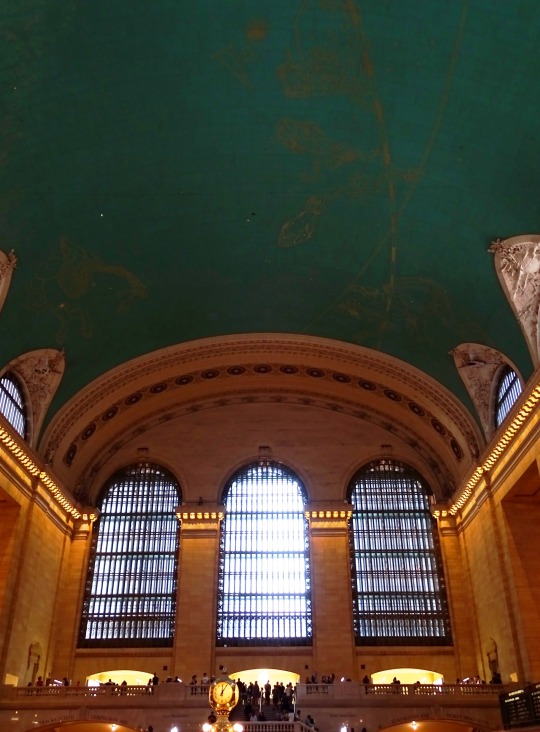

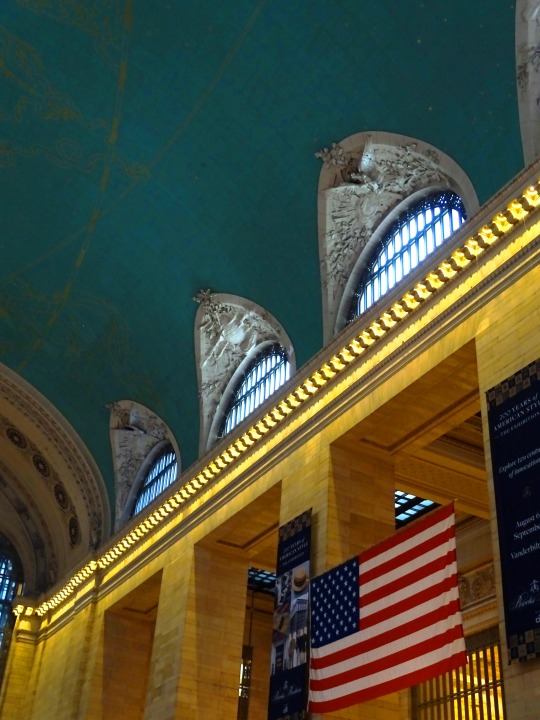
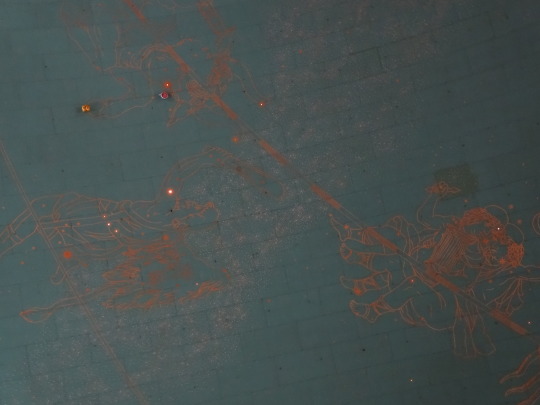
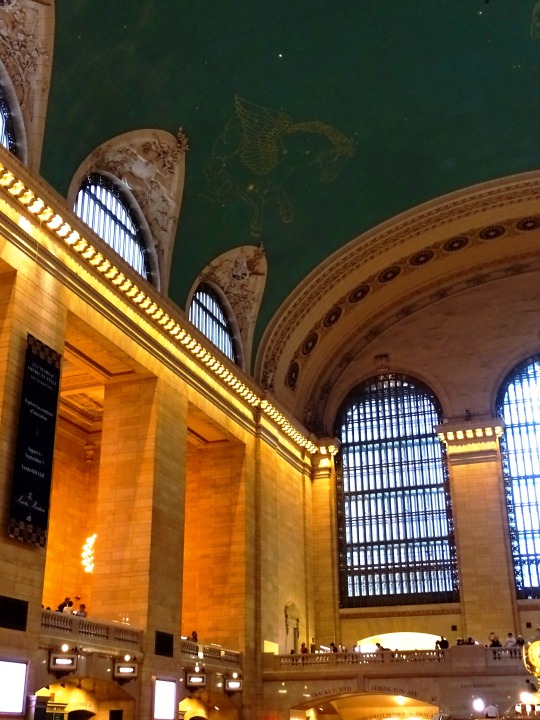

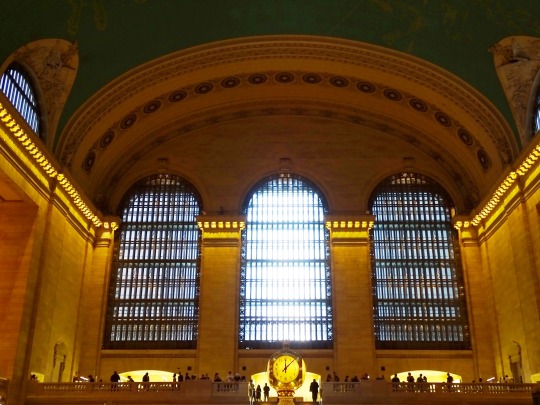
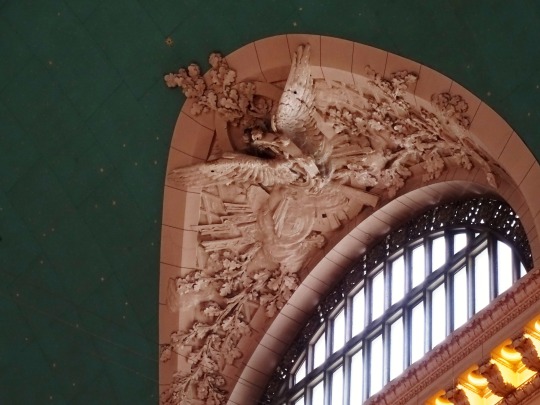

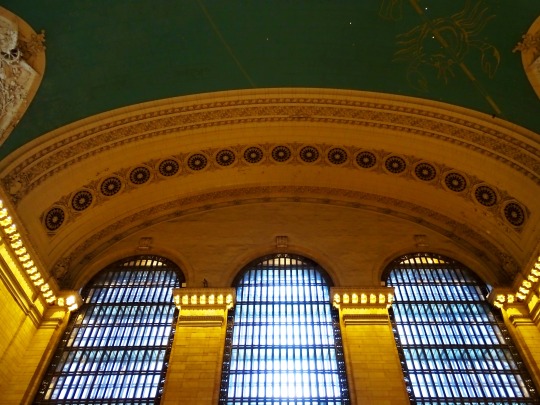
Grand Central Terminal, Manhattan (No. 2)
The Main Concourse, originally known as the Express Concourse, is located on the upper platform level of Grand Central, in the geographical center of the station building. The 35,000-square-foot (3,300 m2) concourse leads directly to most of the terminal's upper-level tracks, although some are accessed from passageways near the concourse.The Main Concourse is usually filled with bustling crowds and is often used as a meeting place.
The terminal's ticket booths are located in the Main Concourse, although many have been closed or repurposed since the introduction of ticket vending machines. The concourse's large American flag was installed there a few days after the September 11 attacks on the World Trade Center. The Main Concourse is surrounded on most of its sides by balconies. The east side is occupied by an Apple Store, while the west side is occupied by the Italian restaurant Cipriani Dolci (part of Cipriani S.A.), the Campbell Palm Court, and the Campbell Bar, a former financier's office-turned-bar. Underneath the east and west balconies are entrances to Grand Central's passageways, with shops and ticket machines along the walls.
The 18-sided main information booth — originally the "information bureau" — is in the center of the concourse. Its attendants provide train schedules and other information to the public; in 2015, they fielded more than 1,000 questions an hour, according to an MTA spokesman. A door within the marble and brass pagoda conceals a spiral staircase down to a similar booth on the station's Dining Concourse.
The booth is topped by a four-faced brass clock, one of Grand Central's most recognizable icons. The clock was designed by Henry Edward Bedford and cast in Waterbury, Connecticut. Its mechanism was designed by the Self Winding Clock Company and built by the Seth Thomas Clock Company, along with several other clocks in the terminal. Each 24-inch (61 cm) face is made from opalescent glass, now often called opal glass or milk glass. An urban legend, which arose in news reports in the 1990s or even earlier, claimed that the clock faces were actually made of opal, a precious gem, and that renowned auction houses had estimated their worth at millions of dollars. This myth was spread by tour guides in the terminal, by its presentation as fact in Wikipedia from 2006 to 2013, and by major news publications into the present day. It was debunked by Untapped Cities in 2020.
The clock was first stopped for repairs in 1954, after it was found to be losing a minute or two per day. One of the four original clock faces was damaged in 1968 by a police officer's bullet, while he chased members of the Youth International Party who staged a protest inside the terminal. The cracked face was removed in the 1990s during the terminal's restoration. It was replaced with a replica; the original is now part of the New York Transit Museum collection.
Along with the rest of the New York Central Railroad system's clocks, it was formerly set to a clock in the train dispatcher's office at Grand Central.Through the 1980s, they were set to a master clock at a workshop in Grand Central. Since 2004, they have been set to the United States Naval Observatory's atomic clock, accurate to a billionth of a second.
Source: Wikipedia
#Main Concourse#Grand Central Terminal#Beaux Arts#Reed and Stem#USA#Warren and Wetmore#interior#original photography#summer 2018#ceiling#travel#vacation#landmark#tourist attraction#architecture#cityscape#Midtown Manhattan#New York City#Henry Edward Bedford#information booth clock#Main Concourse ceiling#elliptical barrel vaul#mural#mural of constellations#Paul César Helleu#lamp#window
2 notes
·
View notes
Text
What Scientists Found After Sifting Through Dust in the Solar System
NASA - STEREO Mission logo.
March 12, 2019
Just as dust gathers in corners and along bookshelves in our homes, dust piles up in space too. But when the dust settles in the solar system, it’s often in rings. Several dust rings circle the Sun. The rings trace the orbits of planets, whose gravity tugs dust into place around the Sun, as it drifts by on its way to the center of the solar system.
The dust consists of crushed-up remains from the formation of the solar system, some 4.6 billion years ago — rubble from asteroid collisions or crumbs from blazing comets. Dust is dispersed throughout the entire solar system, but it collects at grainy rings overlying the orbits of Earth and Venus, rings that can be seen with telescopes on Earth. By studying this dust — what it’s made of, where it comes from, and how it moves through space — scientists seek clues to understanding the birth of planets and the composition of all that we see in the solar system.
Two recent studies report new discoveries of dust rings in the inner solar system. One study uses NASA data to outline evidence for a dust ring around the Sun at Mercury’s orbit. A second study from NASA identifies the likely source of the dust ring at Venus’ orbit: a group of never-before-detected asteroids co-orbiting with the planet.
“It’s not every day you get to discover something new in the inner solar system,” said Marc Kuchner, an author on the Venus study and astrophysicist at NASA’s Goddard Space Flight Center in Greenbelt, Maryland. “This is right in our neighborhood.”
Image above: In this illustration, several dust rings circle the Sun. These rings form when planets’ gravities tug dust grains into orbit around the Sun. Recently, scientists have detected a dust ring at Mercury’s orbit. Others hypothesize the source of Venus’ dust ring is a group of never-before-detected co-orbital asteroids.
Image Credits: NASA’s Goddard Space Flight Center/Mary Pat Hrybyk-Keith.
Another Ring Around the Sun
Guillermo Stenborg and Russell Howard, both solar scientists at the Naval Research Laboratory in Washington, D.C., did not set out to find a dust ring. “We found it by chance,” Stenborg said, laughing. The scientists summarized their findings in a paper published in The Astrophysical Journal on Nov. 21, 2018.
They describe evidence of a fine haze of cosmic dust over Mercury’s orbit, forming a ring some 9.3 million miles wide. Mercury — 3,030 miles wide, just big enough for the continental United States to stretch across — wades through this vast dust trail as it circles the Sun.
Ironically, the two scientists stumbled upon the dust ring while searching for evidence of a dust-free region close to the Sun. At some distance from the Sun, according to a decades-old prediction, the star’s mighty heat should vaporize dust, sweeping clean an entire stretch of space. Knowing where this boundary is can tell scientists about the composition of the dust itself, and hint at how planets formed in the young solar system.
So far, no evidence has been found of dust-free space, but that’s partly because it would be difficult to detect from Earth. No matter how scientists look from Earth, all the dust in between us and the Sun gets in the way, tricking them into thinking perhaps space near the Sun is dustier than it really is.
Stenborg and Howard figured they could work around this problem by building a model based on pictures of interplanetary space from NASA’s STEREO satellite — short for Solar and Terrestrial Relations Observatory.
Image above: Scientists think planets start off as mere grains of dust. They emerge from giant disks of gas and dust that circle young stars. Gravity and other forces cause material within the disk to collide and coalesce. (illustration) Image Credits: NASA’s Jet Propulsion Laboratory.
Ultimately, the two wanted to test their new model in preparation for NASA’s Parker Solar Probe, which is currently flying a highly elliptic orbit around the Sun, swinging closer and closer to the star over the next seven years. They wanted to apply their technique to the images Parker will send back to Earth and see how dust near the Sun behaves.
Scientists have never worked with data collected in this unexplored territory, so close to the Sun. Models like Stenborg and Howard’s provide crucial context for understanding Parker Solar Probe’s observations, as well as hinting at what kind of space environment the spacecraft will find itself in — sooty or sparkling clean.
Two kinds of light show up in STEREO images: light from the Sun’s blazing outer atmosphere — called the corona — and light reflected off all the dust floating through space. The sunlight reflected off this dust, which slowly orbits the Sun, is about 100 times brighter than coronal light.
“We’re not really dust people,” said Howard, who is also the lead scientist for the cameras on STEREO and Parker Solar Probe that take pictures of the corona. “The dust close to the Sun just shows up in our observations, and generally, we have thrown it away.” Solar scientists like Howard — who study solar activity for purposes such as forecasting imminent space weather, including giant explosions of solar material that the Sun can sometimes send our way — have spent years developing techniques to remove the effect of this dust. Only after removing light contamination from dust can they clearly see what the corona is doing.
STEREO spacecrafts. Image Credit: NASA
The two scientists built their model as a tool for others to get rid of the pesky dust in STEREO — and eventually Parker Solar Probe — images, but the prediction of dust-free space lingered in the back of their minds. If they could devise a way of separating the two kinds of light and isolate the dust-shine, they could figure out how much dust was really there. Finding that all the light in an image came from the corona alone, for example, could indicate they’d found dust-free space at last.
Mercury’s dust ring was a lucky find, a side discovery Stenborg and Howard made while they were working on their model. When they used their new technique on the STEREO images, they noticed a pattern of enhanced brightness along Mercury’s orbit — more dust, that is — in the light they’d otherwise planned to discard.
“It wasn’t an isolated thing,” Howard said. “All around the Sun, regardless of the spacecraft’s position, we could see the same five percent increase in dust brightness, or density. That said something was there, and it’s something that extends all around the Sun.”
Scientists never considered that a ring might exist along Mercury’s orbit, which is maybe why it’s gone undetected until now, Stenborg said. “People thought that Mercury, unlike Earth or Venus, is too small and too close to the Sun to capture a dust ring,” he said. “They expected that the solar wind and magnetic forces from the Sun would blow any excess dust at Mercury’s orbit away.”
With an unexpected discovery and sensitive new tool under their belt, the researchers are still interested in the dust-free zone. As Parker Solar Probe continues its exploration of the corona, their model can help others reveal any other dust bunnies lurking near the Sun.
Asteroids Hiding in Venus’ Orbit
This isn’t the first time scientists have found a dust ring in the inner solar system. Twenty-five years ago, scientists discovered that Earth orbits the Sun within a giant ring of dust. Others uncovered a similar ring near Venus’ orbit, first using archival data from the German-American Helios space probes in 2007, and then confirming it in 2013, with STEREO data.
Since then, scientists determined the dust ring in Earth’s orbit comes largely from the asteroid belt, the vast, doughnut-shaped region between Mars and Jupiter where most of the solar system’s asteroids live. These rocky asteroids constantly crash against each other, sloughing dust that drifts deeper into the Sun’s gravity, unless Earth’s gravity pulls the dust aside, into our planet’s orbit.
At first, it seemed likely that Venus’ dust ring formed like Earth’s, from dust produced elsewhere in the solar system. But when Goddard astrophysicist Petr Pokorny modeled dust spiraling toward the Sun from the asteroid belt, his simulations produced a ring that matched observations of Earth’s ring — but not Venus’.
This discrepancy made him wonder if not the asteroid belt, where else does the dust in Venus’ orbit come from? After a series of simulations, Pokorny and his research partner Marc Kuchner hypothesized it comes from a group of never-before-detected asteroids that orbit the Sun alongside Venus. They published their work in The Astrophysical Journal Letters on March 12, 2019.
Venus Dust Ring
Video above: This visualization displays a simulation of the dust ring at Venus’ orbit around the Sun. Scientists hypothesize a group of never-before-detected asteroids orbiting the Sun with Venus are responsible for supplying Venus’ dust ring. Video Credits: NASA’s Scientific Visualization Studio/Tom Bridgman.
“I think the most exciting thing about this result is it suggests a new population of asteroids that probably holds clues to how the solar system formed,” Kuchner said. If Pokorny and Kuchner can observe them, this family of asteroids could shed light on Earth and Venus’ early histories. Viewed with the right tools, the asteroids could also unlock clues to the chemical diversity of the solar system.
Because it’s dispersed over a larger orbit, Venus’ dust ring is much larger than the newly detected ring at Mercury’s. About 16 million miles from top to bottom and 6 million miles wide, the ring is littered with dust whose largest grains are roughly the size of those in coarse sandpaper. It’s about 10 percent denser with dust than surrounding space. Still, it’s diffuse — pack all the dust in the ring together, and all you’d get is an asteroid two miles across.
Using a dozen different modeling tools to simulate how dust moves around the solar system, Pokorny modeled all the dust sources he could think of, looking for a simulated Venus ring that matched the observations. The list of all the sources he tried sounds like a roll call of all the rocky objects in the solar system: Main Belt asteroids, Oort Cloud comets, Halley-type comets, Jupiter-family comets, recent collisions in the asteroid belt.
“But none of them worked,” Kuchner said. “So, we started making up our own sources of dust.”
Perhaps, the two scientists thought, the dust came from asteroids much closer to Venus than the asteroid belt. There could be a group of asteroids co-orbiting the Sun with Venus — meaning they share Venus’ orbit, but stay far away from the planet, often on the other side of the Sun. Pokorny and Kuchner reasoned a group of asteroids in Venus’ orbit could have gone undetected until now because it’s difficult to point earthbound telescopes in that direction, so close to the Sun, without light interference from the Sun.
Image above: Asteroids represent building blocks of the solar system’s rocky planets. When they collide in the asteroid belt, they shed dust that scatters throughout the solar system, which scientists can study for clues to the early history of planets. (illustration) Image Credits: NASA's Goddard Space Flight Center Conceptual Image Lab.
Co-orbiting asteroids are an example of what’s called a resonance, an orbital pattern that locks different orbits together, depending on how their gravitational influences meet. Pokorny and Kuchner modeled many potential resonances: asteroids that circle the Sun twice for every three of Venus’ orbits, for example, or nine times for Venus’ ten, and one for one. Of all the possibilities, one group alone produced a realistic simulation of the Venus dust ring: a pack of asteroids that occupies Venus’ orbit, matching Venus’ trips around the Sun one for one.
But the scientists couldn’t just call it a day after finding a hypothetical solution that worked. “We thought we’d discovered this population of asteroids, but then had to prove it and show it works,” Pokorny said. “We got excited, but then you realize, ‘Oh, there’s so much work to do.’”
They needed to show that the very existence of the asteroids makes sense in the solar system. It would be unlikely, they realized, that asteroids in these special, circular orbits near Venus arrived there from somewhere else like the asteroid belt. Their hypothesis would make more sense if the asteroids had been there since the very beginning of the solar system.
The scientists built another model, this time starting with a throng of 10,000 asteroids neighboring Venus. They let the simulation fast forward through 4.5 billion years of solar system history, incorporating all the gravitational effects from each of the planets. When the model reached present-day, about 800 of their test asteroids survived the test of time.
Pokorny considers this an optimistic survival rate. It indicates that asteroids could have formed near Venus’ orbit in the chaos of the early solar system, and some could remain there today, feeding the dust ring nearby.
The next step is actually pinning down and observing the elusive asteroids. “If there’s something there, we should be able to find it,” Pokorny said. Their existence could be verified with space-based telescopes like Hubble, or perhaps interplanetary space-imagers similar to STEREO’s. Then, the scientists will have more questions to answer: How many of them are there, and how big are they? Are they continuously shedding dust, or was there just one break-up event?
Dust Rings Around Other Stars
Image above: In this illustration, an asteroid breaks apart under the powerful gravity of LSPM J0207+3331, a white dwarf star located around 145 light-years away. Scientists think crumbling asteroids supply the dust rings surrounding this old star. Image Credits: NASA’s Goddard Space Flight Center/Scott Wiessinger.
The dust rings that Mercury and Venus shepherd are just a planet or two away, but scientists have spotted many other dust rings in distant star systems. Vast dust rings can be easier to spot than exoplanets, and could be used to infer the existence of otherwise hidden planets, and even their orbital properties.
But interpreting extrasolar dust rings isn’t straightforward. “In order to model and accurately read the dust rings around other stars, we first have to understand the physics of the dust in our own backyard,” Kuchner said. By studying neighboring dust rings at Mercury, Venus and Earth, where dust traces out the enduring effects of gravity in the solar system, scientists can develop techniques for reading between the dust rings both near and far.
Related links:
Astrophysical Journal Letters: https://iopscience.iop.org/article/10.3847/2041-8213/ab0827
STEREO (Solar TErrestrial RElations Observatory): http://www.nasa.gov/mission_pages/stereo/main/index.html
STEREO data: https://www.uclan.ac.uk/news/new_space_dust_ring_discovered_near_venus.php
Solar System: https://www.nasa.gov/topics/solarsystem/index.html
NASA’s Parker Solar Probe: http://nasa.gov/parker
Helios space probes: https://solarsystem.nasa.gov/missions/helios-2/in-depth/
Images (mentioned), Video (mentioned), Text, Credits: NASA/Rob Garner/Goddard Space Flight Center, by Lina Tran.
Greetibgs, Orbiter.ch
Full article
80 notes
·
View notes
